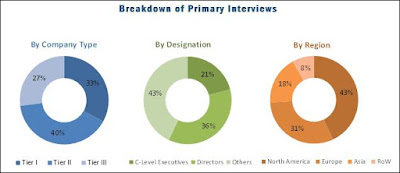Major Objectives of this Study:
# To define, describe, and forecast the Global Protein Binding Assay Industry on the basis of technology, end user, and regions.
# To provide detailed information about factors influencing market growth (drivers, restraints, opportunities, and industry-specific challenges).
# To strategically analyze the micromarkets with respect to individual growth trends, prospects, and contributions to the overall market.
# To analyze market opportunities for stakeholders and provide details of the competitive landscape for key players.
# To forecast the size of the market segments with respect to four major regional segments, namely, North America, Europe, Asia Pacific, and the Rest of the World (RoW).
# To profile the key players in the market and comprehensively analyze their market positions and core competencies.
# To track and analyze competitive developments such as partnerships, agreements, and joint ventures; mergers and acquisitions; product development; and research and development activities in the protein binding assay market
Factors Influencing Global Industry Growth:-
The increasing use of protein binding assays in pre-clinical research for studying the distribution properties of the drug, and the growing number of drug discovery activities, the minimizing drug discovery and development costs, and the increase in pharmaceutical R&D expenditure is driving the growth of this market.

Restraints:
# Issues with Existing Technologies
Opportunities:
# Growing CRO Industry
Challenges:
# Development of in Silico-Based Prediction Models
Looking Out for More Details | Don’t Hesitate to Download the PDF Brochure@
https://www.marketsandmarkets.com/pdfdownloadNew.asp?id=44025612
Industry’s Revenue Growth Expectations:
The global protein binding assays market is projected to reach USD 425.7 million in 2023 from USD 256.1 million in 2018, at CAGR of 10.7%.
Geographical Growth Scenario:
Asia Pacific is expected to grow at the highest CAGR during the forecast period
The APAC market is projected to register the highest growth rate during the forecast period primarily due to factors such as, growth of clinical trial activities in several APAC countries. As a result of this, the pharmaceutical and biopharmaceutical companies are outsourcing their drug discovery and development activities to APAC-based CROs. This is one of the major factors driving the growth of the protein binding assay market in the Asia Pacific.
Target Audience:
# Government and academic institutes
# Protein binding assay providers
# R&D departments
# Contract research organizations
# Pharmaceutical & biotechnology companies
# Consulting firms
# Government associations

Leading Market Players:
# HTDialysis (US)
# Thermo Fisher Scientific (US)
# Merck (Germany)
# Sovicell (Germany) and many more…
Most companies focus on agreements, collaborations, and partnerships to compete in the market. The players also focus on increasing their presence in high-growth markets through acquisitions and product launches.
Thermo Fisher (US), Sovicell (Germany) and 3B Pharmaceutical focus on partnerships, collaboration and license agreements to strengthen their position in the market.
Read More:
https://www.marketsandmarkets.com/PressReleases/protein-binding-assay.asp
In 2017, Thermo Fisher was the leading player in the protein binding assay market. The company has a strong geographic presence across the US, Europe, Greater China, and Asia Pacific. The company focuses on a wide range of products offering in the protein binding assay market.
The company’s products are based on the equilibrium dialysis technology, which helps it dominate this market. The company focuses on partnerships to enhance its presence in the market. In 2018, Thermo Fisher partnered with The Montreal Neurological Institute (The Neuro) of the McGill University (Canada) to provide reagents and tools to understand neurological diseases.